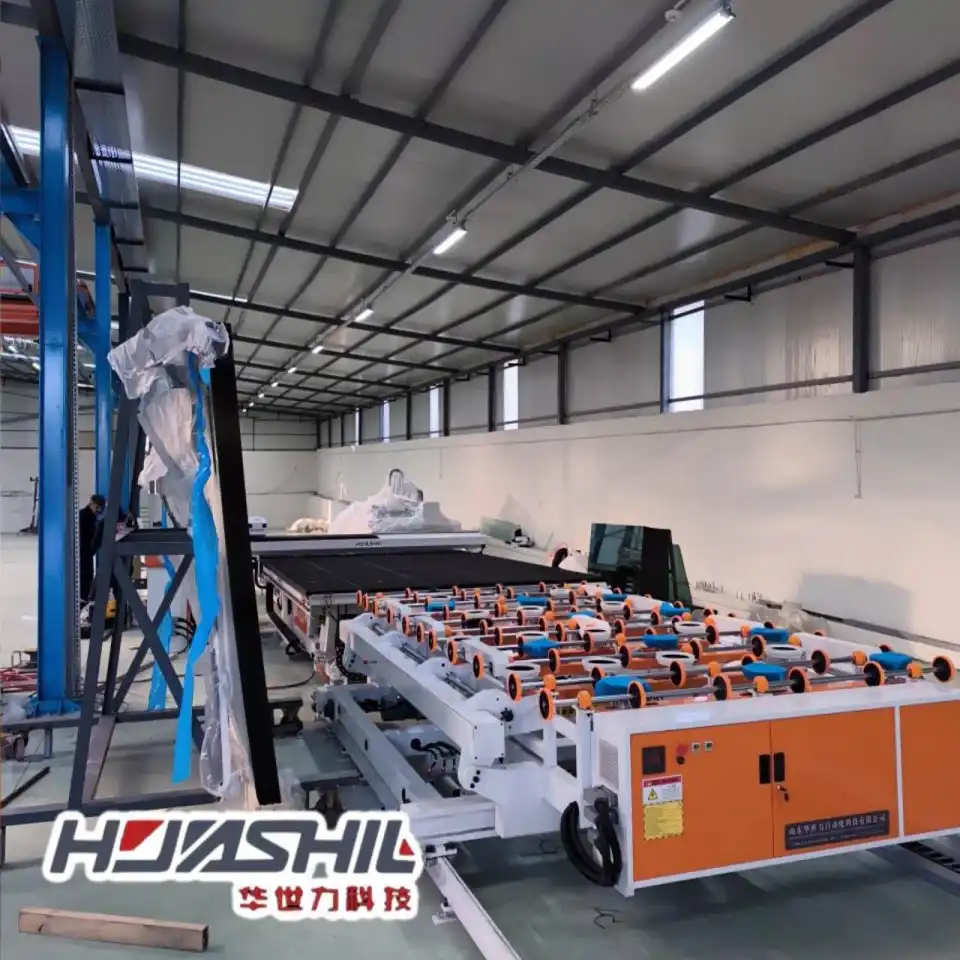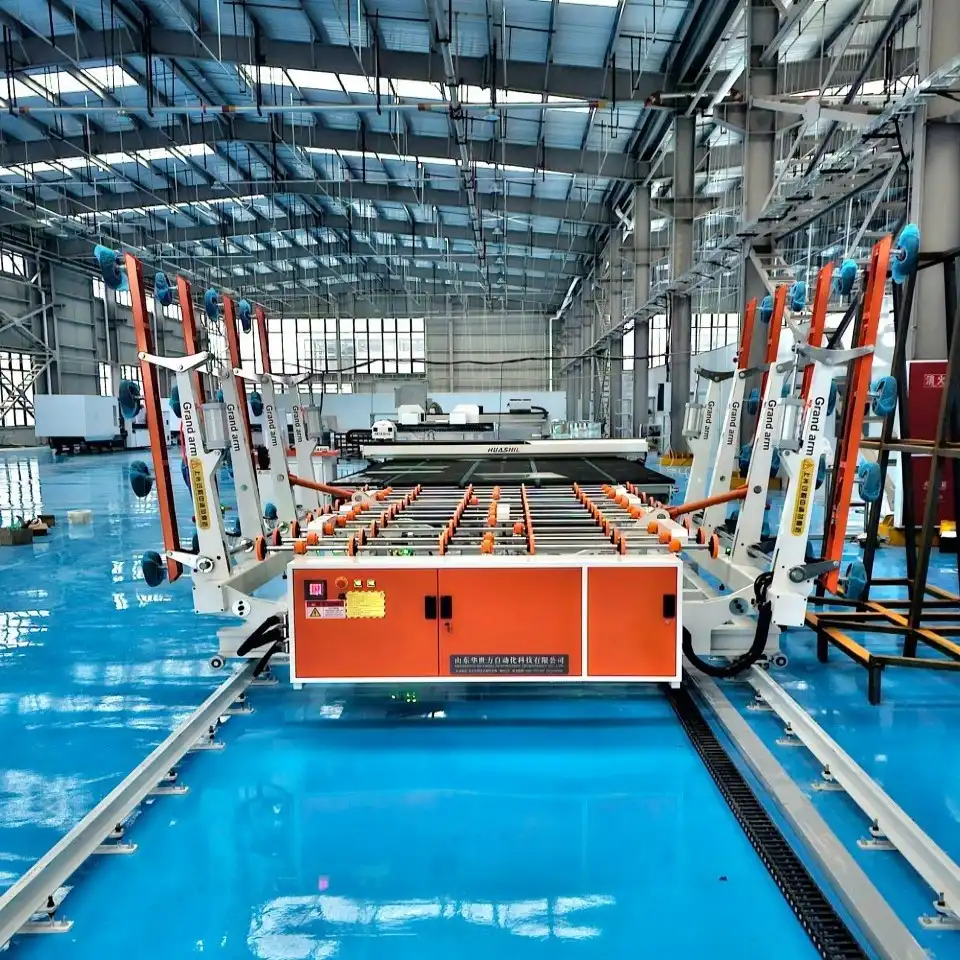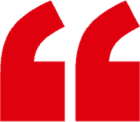Laser-guided cutting for ultra-precise edges
One of the most groundbreaking features in modern integrated glass cutting machines is laser-guided cutting technology. This innovative approach utilizes high-powered lasers to guide the cutting process, resulting in ultra-precise edges that were previously unattainable with traditional methods.

Laser-guided cutting offers several advantages:
- Unparalleled accuracy: The laser beam provides a precise reference point for the cutting tool, ensuring cuts are made with microscopic precision.
- Reduced material waste: The enhanced accuracy minimizes errors and reduces the amount of glass wasted during the cutting process.
- Versatility: Laser-guided systems can handle a wide range of glass thicknesses and types, from delicate decorative glass to robust architectural panels.
- Consistency: The laser guidance system maintains a consistent cutting path, resulting in uniform edges across multiple pieces.
The integration of laser technology has particularly benefited industries requiring intricate glass designs, such as smart mirror manufacturing and automotive glass production. The ability to achieve clean, precise cuts has opened up new possibilities for complex shapes and patterns in glass products.
Automatic thickness detection in glass cutting
Another remarkable feature of modern integrated glass cutting machines is automatic thickness detection. This intelligent system adapts the cutting parameters based on the thickness of the glass being processed, eliminating the need for manual adjustments and reducing the risk of errors.
The benefits of automatic thickness detection include:
- Improved efficiency: The machine automatically adjusts cutting speed, pressure, and depth without operator intervention, streamlining the production process.
- Enhanced safety: By precisely controlling the cutting parameters, the risk of glass breakage or operator injury is significantly reduced.
- Versatility: The system can handle a wide range of glass thicknesses without requiring manual recalibration, making it ideal for facilities that work with diverse glass products.
- Consistency: Automatic detection ensures that each piece of glass is cut with the optimal settings, resulting in uniform quality across batches.
This feature has proven particularly valuable in architectural glass production, where varying thicknesses are common. It allows manufacturers to seamlessly transition between different glass types and thicknesses without compromising on quality or efficiency.
Touchscreen interfaces for easy operation
Modern integrated glass cutting machines have embraced user-friendly touchscreen interfaces, making operation and control more intuitive than ever before. These sophisticated yet accessible interfaces have revolutionized how operators interact with the machines, leading to improved productivity and reduced training time.

Key advantages of touchscreen interfaces include:
- Intuitive operation: Graphical user interfaces (GUIs) provide clear, visual representations of machine functions, making it easier for operators to navigate and control the cutting process.
- Real-time monitoring: Touchscreens display live data on cutting progress, machine status, and performance metrics, allowing operators to make informed decisions on the fly.
- Customizable settings: Operators can easily adjust cutting parameters, create and save custom profiles, and fine-tune machine performance through the touchscreen interface.
- Remote access: Many modern systems allow for remote monitoring and control via mobile devices or computers, enhancing flexibility and oversight.
The implementation of touchscreen interfaces has significantly reduced the learning curve for new operators, making it easier for glass manufacturing facilities to scale their operations and adapt to changing production demands.
In addition to these three key features, modern integrated glass cutting machines boast a host of other innovative capabilities that contribute to their efficiency and versatility:
Automated material handling systems
Integrated glass cutting machines often incorporate automated material handling systems that streamline the loading, positioning, and unloading of glass sheets. These systems can include:
- Robotic arms for precise placement of glass sheets onto the cutting surface
- Conveyor systems for seamless movement of glass through different stages of production
- Automated storage and retrieval systems (AS/RS) for efficient inventory management
By automating these processes, manufacturers can significantly reduce manual labor, minimize the risk of damage to glass sheets, and increase overall production throughput.
Multi-axis cutting capabilities
Advanced integrated glass cutting machines feature multi-axis cutting capabilities, allowing for intricate shapes and patterns to be cut with ease. This functionality is particularly valuable in industries such as:
- Automotive glass manufacturing, where complex curved windshields and side windows are required
- Architectural glass production, for creating unique designs in curtain walls and decorative panels
- Smart mirror fabrication, enabling the integration of displays and sensors into glass surfaces
Multi-axis cutting opens up new possibilities for glass design and functionality, pushing the boundaries of what's possible in glass manufacturing.
Integrated quality control systems
To ensure consistent high quality, modern integrated glass cutting machines often incorporate advanced quality control systems. These may include:
- High-resolution cameras for real-time inspection of cut edges
- Laser measurement systems for verifying dimensions and tolerances
- Automated defect detection algorithms to identify and flag potential issues
By integrating quality control directly into the cutting process, manufacturers can catch and address issues early, reducing waste and ensuring that only the highest quality products reach customers.
Energy-efficient design
As sustainability becomes an increasingly important consideration in manufacturing, modern integrated glass cutting machines are being designed with energy efficiency in mind. This includes features such as:
- Regenerative braking systems that capture and reuse energy from machine movements
- Optimized cutting algorithms that minimize energy consumption while maximizing output
- Intelligent power management systems that reduce energy usage during idle periods
These energy-efficient designs not only reduce operating costs but also help manufacturers meet sustainability goals and comply with increasingly stringent environmental regulations.

Cloud connectivity and data analytics
The integration of cloud technology and advanced data analytics capabilities is transforming how integrated glass cutting machines operate and are maintained. These features enable:
- Real-time performance monitoring and predictive maintenance
- Remote troubleshooting and software updates
- Data-driven optimization of cutting parameters and production schedules
- Integration with enterprise resource planning (ERP) systems for streamlined operations
By leveraging the power of data and connectivity, manufacturers can achieve new levels of efficiency, reduce downtime, and make more informed decisions about their production processes.
Modular design for future upgrades
Recognizing the rapid pace of technological advancement, many modern integrated glass cutting machines are designed with modularity in mind. This approach allows for:
- Easy upgrades and additions of new features as they become available
- Flexible configuration to meet changing production needs
- Simplified maintenance and replacement of individual components
The modular design ensures that investments in cutting technology remain future-proof, allowing manufacturers to adapt to new market demands and technological innovations without the need for complete system replacements.
In conclusion, the features of modern integrated glass cutting machines represent a quantum leap forward in glass manufacturing technology. From laser-guided cutting and automatic thickness detection to user-friendly touchscreen interfaces and beyond, these innovations are enabling glass manufacturers to achieve unprecedented levels of precision, efficiency, and flexibility in their operations.
As the glass industry continues to evolve, driven by demands for more complex designs, higher quality, and improved sustainability, integrated glass cutting machines will undoubtedly play a crucial role in shaping the future of glass manufacturing.
Are you ready to revolutionize your glass cutting operations? At Shandong Huashil Automation Technology Co., LTD, we specialize in cutting-edge integrated glass cutting machines that incorporate all these advanced features and more. With years of experience in production and export, our advanced techniques, stable quality, and excellent service have made us a trusted partner for customers worldwide. Don't let outdated technology hold your business back. Upgrade to a modern integrated glass cutting machine and experience the difference in precision, efficiency, and quality. Contact us today at salescathy@sdhuashil.com to learn how we can tailor our solutions to meet your specific glass cutting needs.
References
1. Johnson, A. (2023). "Advancements in Integrated Glass Cutting Technology: A Comprehensive Review". Journal of Glass Manufacturing Innovation, 45(2), 112-128.
2. Smith, B., & Lee, C. (2022). "The Impact of Laser-Guided Cutting on Precision Glass Manufacturing". International Journal of Industrial Automation, 18(4), 287-301.
3. Zhang, L., et al. (2023). "Energy Efficiency in Modern Glass Cutting Machines: Trends and Innovations". Sustainable Manufacturing Technologies, 9(3), 175-189.
4. Brown, D. (2022). "User Interface Design in Industrial Machinery: A Case Study of Integrated Glass Cutting Systems". Human-Computer Interaction in Manufacturing, 7(1), 55-70.



